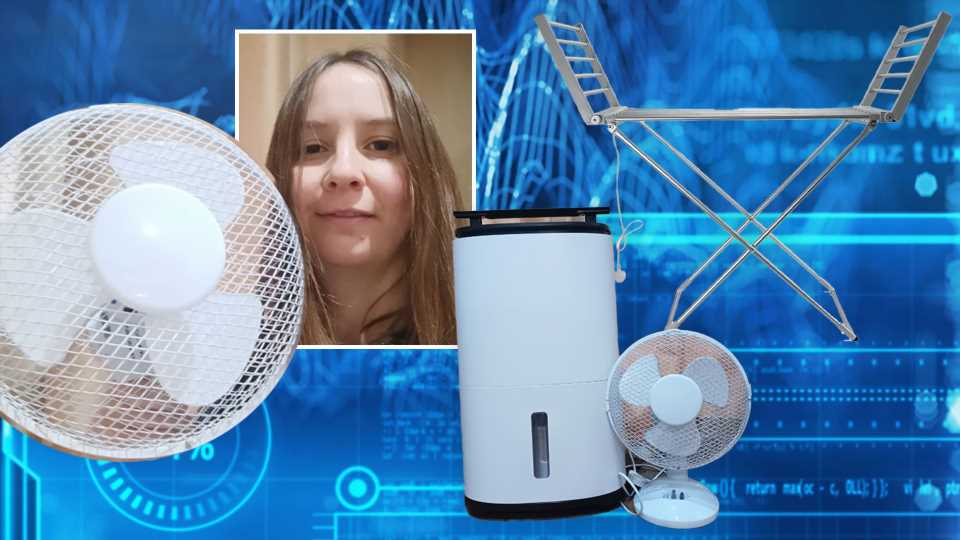IT’S cold and wet outside and there's no chance of my washing drying on the line.
But with two small messy kids, I need a drying solution that’s not only cheap but quick enough to cope with our ever-increasing piles of muddy laundry.
I was given the chance to test a cutting-edge dehumidifier and heated airer to see which one dries my washing best.
In truth, I had serious doubts about the dehumidifier.
I have an old one already and it’s brilliant for sucking all the moisture out of the air but I didn’t get how it dried clothes.
I thought some kind of heat was needed for that, like a tumble dryer or radiator.
Read more on energy bills

Your radiators are in the wrong place in your home and it's adding £100 to bills

Full list of cold weather payments worth up to £4,600 to help with energy bills
I asked manufacturer Meaco to explain this to me, as well as loan me one of their models to try.
The MeacoDry 20L Arete One, costing £259.99, is a monster compared to my seven-year-old ageing dehumidifier and looked like it would take no prisoners so far as damp is concerned.
It also has a dedicated “laundry mode”, for drying clothes really fast, costing between 6p and 7p an hour, based on current standard tariffs.
Chris Michael, Meaco’s managing director, said compressor dehumidifiers like this one dry clothes by absorbing the moisture in the air from the wet washing.
Most read in Money

Chain with 100 locations to take over former Wilko stores – it’s not Poundland

Thousands of households to get £100 free cash – key date to make a claim

Energy bill warning for 7million as huge switch-off to cripple smart meters

I never use my dryer thanks to 50p Tesco essential which sucks up moisture
They do this by creating a cold surface inside them which draws in and condenses the damp air, with the tiny molecules of liquid falling into a container at the bottom.
The dried-out air is warmed back up to room temperature and then blown back into the room.
Test one – dehumidifier
For my first test, I set the dehumidifier to its “smart laundry mode” and hung out a wet load of washing around it on some airers.
Normally it takes about a day for clothes to dry inside, but with a substantial dehumidifier next to it the job was done in eight hours.
I was impressed. It cost me 53p, according to my smart plug.
The laundry mode takes the humidity of the room to a really low level, aiming at 35 per cent RH (relative humidity).
This helps to quickly draw the moisture out of the clothes, as well as having a higher fan speed to create a breeze.
A normal RH level is around 50 to 55% – and that’s what the dehumidifier will aim for if you have it in the standard smart humidity mode.
Test two – heated airer
Next came the turn of my heated airer, a Status model currently costing £49.99, from Amazon.
I timed how long it would dry out a family load of washing, the same as I had done in the previous test.
I noticed that the parts of the garment that were in contact with the heated bars dried in no time but the bits that hung down from the bars weren't drying very quickly.
So I was constantly fiddling with the clothes and moving them around so different areas of the garment could come into contact with the heat.
Everything was dry in 10 hours but that was with me giving them a helping hand.
But it's definitely faster than a normal airer which takes up to a day to get our clothes properly dry.
Typical consumption is 230watts, according to the product’s specification, but my smart plug found it was around 246watts, which would mean the cost is just under 7p an hour.
Drying a load of washing with the airer cost me 67p.
I found it’s better to dry clothes by laying them across the bars, rather than hanging loads off of them.
But of course if like me you have loads of washing you're going to want to pile it all on at once.
I don’t like the idea of using a heated airer without a dehumidifier, as I know from miserable experience that all that moisture needs to evaporate somewhere.
If it doesn’t go out of a window or into a dehumidifier, it’s going to condense on the walls and turn into mould.
So if I had to choose between the airer and dehumidifier, I’d go for the latter, as it not only dries clothes but also deals with the mould and moisture – all for similar energy consumption, around 245 – 250watts.
Of course, I could open the windows, if I didn’t have a dehumidifier, but that just isn’t an option with a young family to keep warm.
The little-known trick to speed up the drying
However, that's not the end of the story.
According to Meaco, I was missing a trick when it comes to really fast-drying washing.
Chris said the best way to use a dehumidifier is in combination with a fan – the same cooling one you use on hot summer days.
It turns out I will need it in winter too, as Chris explained its breeze creates the perfect conditions for drying clothes.
"To put it into simple terms, think about how you dry washing outside, you would look for a dry, sunny, windy day," he said.
"This is what you need to recreate indoors to dry laundry."
He reckons the warmth of a normal house is sufficient, and there's no need to use extra heat as this costs more money than necessary.
But the wind from the fan creates perfect conditions for drying, and only costs 1p an hour to run.
“Clothes dry faster on a windy day as the air blowing through them literally forces the moisture out," he said.
"This works faster if the air around the clothes is dry (hence the need for a dehumidifier)."
I gave it a go testing both the dehumidifier on laundry mode, and my old fan perched next to it, its rotating head blowing forcefully across my washing on its highest setting.
The result? In just four and a half hours, everything was dry, including my daughter's thick toddler sleeping bags.
A caveat is that everyone’s drying times will be different – depending on the material used in their clothes, the temperature of their house and how draughty it is.
The room I used was 20C and my washing loads are a typical bundle of kids’ and adult clothing.
I also tested the dehumidifier and heated airer together but after four and a half hours, there were still wet patches on the clothes where they were hanging off the airer’s bars.
At that point I declared the dehumidifier and fan combo the winner.
They cost 35p to use per laundry load, according to the latest energy price cap – a bargain compared to typical dryer costs.
Tumble dryers normally use 3kWh of energy per load, according to uSwitch, which would cost around 81p in total, according to current typical tariffs energy.
So my method halves the cost of a tumble dryer.
Other dehumidifier options
Of course, £259.99 for an Arete One is no small expense – but there are cheaper alternatives.
Emily Seymour, Which? energy editor, said: “Using a dehumidifier is a great way to reduce the effects of condensation in your home.
"By drawing out excess moisture from the air, dehumidifiers can also hold back mould growth and reduce damp on walls.
“How much you want to spend on a dehumidifier will depend on the size of your home, how many people in the household and how damp your home is."
She noted the most expensive models are around £450 and will come with a larger capacity and extra features like a laundry mode.
However, Which? has found "Good Value" models that do a "great job" starting at £120.
Models that cost less than £150 tend to have a capacity of 10 litres or less.
Cheaper dehumidifiers are also less likely to have castors, wheels or a laundry setting.
It's worth looking out for a humidistat feature, which monitors moisture levels in the air and adjusts to your chosen the humidity level you’ve selected, laundry mode – which whacks the fan speed up, wheels and a night mode.
What I learned
I tend to do my washing at night, so in future I’ll probably just hang it up and shut it in a room with my dehumidifier on laundry mode and trust that it will have dried by the morning.
With the Arete One, the laundry mode shuts itself off after six hours, which means you don’t have to worry about turning it off.
If I’m in a rush to get the washing done, I’ll definitely be using the fan to help things along – even in mid-winter.
Read More on The Sun

Rain doesn't stop me from drying my clothes outside – my method's tried & tested

Quality Street fans mourn 'part of Christmas gone' after Nestle makes change
- Dehumidifer in laundry mode: Took 8 hours at 6.7p an hour, costing 53p in total
- Heated airer: Took 10 hours at 6.7p an hour, costing 67p in total
- Dehumidifer and fan: Took 4.5 hours at 6.7p + 1p an hour, costing 35p in total
- Typical tumble dryer costs: 81p per load
The tests were carried out on a single load of washing containing family clothes.
Do you have a money problem that needs sorting? Get in touch by emailing [email protected].
You can also join our new Sun Money Facebook group to share stories and tips and engage with the consumer team and other group members.
Source: Read Full Article





